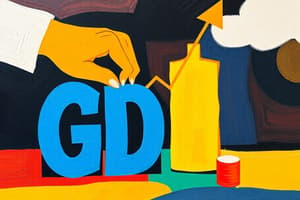Podcast
Questions and Answers
In the AD-AS model, what condition signifies short-run macroeconomic equilibrium?
In the AD-AS model, what condition signifies short-run macroeconomic equilibrium?
- The point where the short-run aggregate supply (SRAS) curve intersects the long-run aggregate supply (LRAS) curve.
- The point where the aggregate demand (AD) curve intersects the long-run aggregate supply (LRAS) curve.
- The quantity of aggregate output demanded equals the potential output.
- The quantity of aggregate output supplied equals the quantity demanded. (correct)
What is the term for an event that causes the Aggregate Demand curve to shift?
What is the term for an event that causes the Aggregate Demand curve to shift?
- Supply-side disrupter
- Market correction
- Demand shock (correct)
- Fiscal adjustment
What is a 'supply shock' in the context of the aggregate demand and aggregate supply model?
What is a 'supply shock' in the context of the aggregate demand and aggregate supply model?
- A government decision to increase spending, leading to higher aggregate demand.
- An event that shifts the short-run aggregate supply curve. (correct)
- An unexpected change in consumer confidence that affects aggregate demand.
- A change in global interest rates that affects investment and aggregate demand.
In the context of macroeconomics, what signifies long-run macroeconomic equilibrium?
In the context of macroeconomics, what signifies long-run macroeconomic equilibrium?
What is a recessionary gap?
What is a recessionary gap?
What characterizes an 'inflationary gap' in macroeconomics?
What characterizes an 'inflationary gap' in macroeconomics?
In the context of a negative demand shock, what is the likely short-run impact on unemployment?
In the context of a negative demand shock, what is the likely short-run impact on unemployment?
Following a negative demand shock, what is the long-run adjustment process that restores the economy to potential output?
Following a negative demand shock, what is the long-run adjustment process that restores the economy to potential output?
How does an eventual increase in nominal wages adjust the economy following a positive demand shock?
How does an eventual increase in nominal wages adjust the economy following a positive demand shock?
Suppose an economy is in short-run equilibrium with real GDP less than potential output. Over time, what adjustment is most likely to occur?
Suppose an economy is in short-run equilibrium with real GDP less than potential output. Over time, what adjustment is most likely to occur?
If an economy's short-run equilibrium real GDP is greater than its potential output, what is the most likely consequence?
If an economy's short-run equilibrium real GDP is greater than its potential output, what is the most likely consequence?
What is the main idea behind macroeconomic stabilization policy?
What is the main idea behind macroeconomic stabilization policy?
The economy is experiencing a negative demand shock with decreased output and rising unemployment. What policy response aligns with active stabilization?
The economy is experiencing a negative demand shock with decreased output and rising unemployment. What policy response aligns with active stabilization?
In the event of a positive demand shock, what action might policymakers take to stabilize the economy?
In the event of a positive demand shock, what action might policymakers take to stabilize the economy?
Why might economists advise against intervening to offset every decline in aggregate demand?
Why might economists advise against intervening to offset every decline in aggregate demand?
What is the policy dilemma posed by a negative supply shock?
What is the policy dilemma posed by a negative supply shock?
In response to a negative supply shock that increases both inflation and unemployment, what action would stabilize prices but likely worsen unemployment?
In response to a negative supply shock that increases both inflation and unemployment, what action would stabilize prices but likely worsen unemployment?
Following a negative supply shock, what strategy would most likely stabilize unemployment levels, despite potentially worsening inflation?
Following a negative supply shock, what strategy would most likely stabilize unemployment levels, despite potentially worsening inflation?
What is the potential drawback of using fiscal or monetary policy to actively stabilize the economy?
What is the potential drawback of using fiscal or monetary policy to actively stabilize the economy?
Flashcards
Short-run macroeconomic equilibrium
Short-run macroeconomic equilibrium
The economy is in this state when the quantity of aggregate output supplied equals the quantity demanded.
Demand shock
Demand shock
An event that causes the aggregate demand curve to shift.
Supply shock
Supply shock
An event that causes the short-run aggregate supply curve to shift.
Long-run macroeconomic equilibrium
Long-run macroeconomic equilibrium
Signup and view all the flashcards
Recessionary gap
Recessionary gap
Signup and view all the flashcards
Inflationary gap
Inflationary gap
Signup and view all the flashcards
Output gap
Output gap
Signup and view all the flashcards
Stabilization policy
Stabilization policy
Signup and view all the flashcards
Study Notes
The Keynesian Income and Expenditure Model
- The AD-AS model is a tool used to analyze economic fluctuations
- Monetary and fiscal policy can stabilize the economy
Short-Run Macroeconomic Equilibrium
- The AD-AS model utilizes aggregate supply and demand curves to analyze economic fluctuations
- The economy is in short-run macroeconomic equilibrium when aggregate output supplied equals aggregate output demanded (ESR)
- Short-run equilibrium inflation rate is denoted as πE
- Short-run equilibrium aggregate output is denoted as YE
Demand Shock
- An event that shifts the AD curve
- A shift of the AD curve can be either a negative or a positive demand shock
Supply Shock
- An event that shifts the SRAS curve
- A shift of the SRAS curve can be either a negative or positive supply shock
Long-Run Macroeconomic Equilibrium
- The economy is in long-run macroeconomic equilibrium when the short-run macroeconomic equilibrium is on the LRAS curve
Recessionary and Inflationary Gaps
- Recessionary gap: aggregate output is below potential output
- Inflationary gap: aggregate output is above potential output
- Output gap: the percentage difference between actual and potential aggregate output
- Output gap is calculated as follows:
- Output gap = (Actual aggregate output − Potential output) / Potential output × 100
Demand Shock Example 1
- Initial negative demand shock
- This reduces π and aggregate output, leading to higher unemployment in the short run (a recessionary gap)
- Until an eventual fall in 𝑾 in the long run increases 𝑆𝑅𝐴𝑆, and moves the economy back to potential output
- Long-run macroeconomic equilibrium is restored at 𝐸3
Demand shock example 2
- Initial positive demand shock
- Increases 𝝅 and aggregate output, leading to lower unemployment in the short run (an inflationary gap)
- Until an eventual increase in 𝑾 in the long run decreases 𝑆𝑅𝐴𝑆 and moves the economy back to potential output.
- Long-run macroeconomic equilibrium is restored at 𝐸3
Practice Question 1
- In short-run equilibrium, if real GDP is less than potential output, then nominal wages fall in the long run and the SRAS curve shifts right, restoring the economy to potential output
Practice Question 2
- If short-run equilibrium real GDP is greater than potential output:
- Nominal wages will have to adjust upward as the economy moves from the short run to the long run
- The level of unemployment is very low
- Jobs are plentiful
- To reach long-run equilibrium, the SRAS curve will shift to the left, resulting in a higher aggregate price level
Macroeconomic Policy
- The economy is self-correcting in the long run, typically taking a decade or more
- Economists advise governments not to wait for the economy to self-correct and to use monetary and fiscal policy to return the economy to potential output
- Stabilization policy: the use of government policy to reduce the severity of recessions and restrain excessively strong expansions
Policy for Demand Shocks
- Negative demand shock: instead of waiting for SRAS to increase in the long run, policymakers can react quickly to the fall in AD
- The government could make the economy stay at the original equilibrium by shifting AD to the right
- Positive demand shock: instead of waiting for SRAS to increase in the long run, policymakers can react quickly to the increase in AD
- The government could make the economy stay at the original equilibrium by shifting AD to the left
- Macroeconomic policy is desirable because:
- The temporary fall in aggregate output is associated with high unemployment
- It Prevents deflation
- Policy makers should always act to offset declines in aggregate demand, but not necessarily because:
- Some policy measures may have long-term costs in terms of lower long-run growth (budget deficits, for example).
- Policy makers are not perfectly informed, and the effects of their policies are not perfectly predictable, which creates the danger that stabilization policy will do more harm than good
Policy for Supply Shocks
- Example: A negative supply shock leads to π↑ and unemployment ↑ and poses a policy dilemma:
- Stabilization of unemployment requires an increase in aggregate demand, which leads to inflation
- Stabilization of prices requires a decrease in aggregate demand, which leads to higher unemployment
Studying That Suits You
Use AI to generate personalized quizzes and flashcards to suit your learning preferences.





